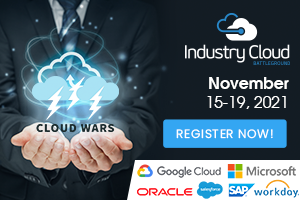CEOs and Boards are usually safe to delegate keeping up with the steady stream of “tech breakthroughs” to their CIOs. But I advise them to pay close attention to the emergence of “industry clouds,” and here’s why.
Some new tech delivers enough competitive advantage that top leaders must understand the implications. There is a shift among cloud providers from offering generic solutions to selling industry clouds that are tailored to solve specific industry problems. It may not sound a big deal, but here are three reasons why industry clouds are worth the attention of business executives:
- Reduced Time to Value: After 30+ years as a CIO, I believe organizations’ processes are 80% standardized across industries, 10% specific to your industry, and 10% unique to your organization. But the IT work needed to support those processes divides as: 1/3 standardized, 1/3 industry, and 1/3 organization[1]. By incorporating industry regulations, specialized accounting treatments, and specific processes and terminology, industry cloud vendors significantly reduce your implementation time.
- Increased Agility: The old model of software was:
- Vendors send your organization periodic (often annual) software releases that incorporate hundreds or thousands of improvements and corrections;
- Your IT team merges local customizations and re-integrates any additional software products you bought to satisfy industry requirements;
- IT and users test this unique conglomeration of software;
- Your old software gets replaced by this new version (and IT works around the clock tweaking and fixing until things stabilize)[2].
Given the risk, cost, and elapsed time, is it any wonder that many organizations run software that’s several years—or even decades—out of date[3]?
Industry cloud software is software as a service, or SaaS. With SaaS, vendors don’t send out big, occasional monolithic releases that your IT team must deal with. SaaS vendors run and maintain their software for you. The vendors make corrections daily or weekly and regularly (often monthly) incorporate improvements. Speed is a massive win in today’s Acceleration Economy: Business users get a steady stream of new functionality—that you pay your vendors big money for—in weeks rather than years!
Life is good, right? Nope, not for IT. Remember one-third of IT’s time & effort is devoted to industry customization. With SaaS before industry clouds, your IT team had to scramble to constantly re-customize and re-integrate and re-test to ensure everything worked as expected. Industry cloud vendors now take care of this for you behind the scenes. That reduces ongoing IT workloads and frees them up for more productive work.
3. Reduced Friction (transaction cost): Industry cloud vendors realize that “no organization is an island” and that various industry participants (buyers, sellers, support vendors, even competitors) spend lots of money connecting with one another to exchange data. Industries with excessive friction are ripe for disruption by innovative market entrants, so it behooves you to become frictionless before you’re targeted. Industry cloud vendors can help in two ways:
- They incorporate standard industry interfaces that simplify your connection to other participants. Saving the cost of designing, programming, and maintaining complex and ever-changing interfaces raises the ROI of interoperability and thus encourages automated interconnections.
- They are partnering with firms that build and operate exchanges and other multi-party connectivity hubs. The value of such exchanges increases exponentially as the number of parties and transactions increases (i.e. the network effect). The ability to quickly and cheaply connect to these emerging hubs allows your organization to participate in network effect synergies.
There are many more reasons for top executives to get excited about the emergence of industry cloud solutions. Join us this week and you’ll hear them from the vendors, some key users, and our Acceleration Economy Analysts!
Industry Cloud Battleground Week
Powering the greatest growth market the world has ever known, industry clouds have become the “reimagination machines” for businesses of all sizes.
Join us for a groundbreaking virtual event Nov. 15-19 as we dive into the customer stories, business innovations, market dynamics, and technology breakthroughs that are powering the industry-cloud phenomenon.
Sponsored by Salesforce, Google Cloud, Oracle, Microsoft, SAP, and Workday, this 5-day digital event delivers the insights to inspire, educate and engage business and technology leaders who are actively defining their industry-specific cloud strategy.
Register here, and we look forward to seeing you!
Article References
I defined these two “Laws of Industry Differentiation” in my May 2021 Cloud Wars Live podcast. Find it here, then jump to minute 18. ↑
If that seems like a lot of work and risk, it is! Go ask your CIO. I left out most of the gory details and risks! ↑
Running software and hardware that’s seriously out of date is called “technical debt,” and is a major cause of cybersecurity breaches, computer outages, and competitive disadvantage. ↑










